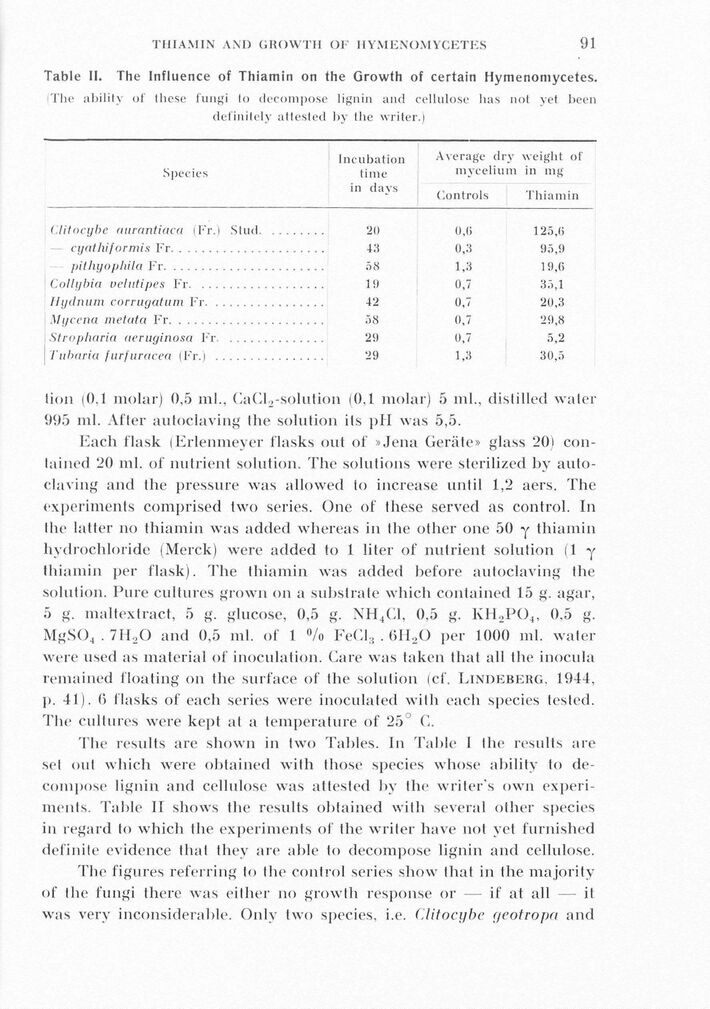
Full resolution (JPEG) - On this page / på denna sida - Sidor ...

<< prev. page << föreg. sida << >> nästa sida >> next page >>
Below is the raw OCR text
from the above scanned image.
Do you see an error? Proofread the page now!
Här nedan syns maskintolkade texten från faksimilbilden ovan.
Ser du något fel? Korrekturläs sidan nu!
This page has never been proofread. / Denna sida har aldrig korrekturlästs.
t|ham in am) ürowth of 11ymenomycetes
91
Table II. The Influence of Thiamin ön the Growth of certain Hymenomycetes.
The ability of Ihese fungi lo decompose lignin and cellulose lias not vet been
definitely attested by the writer.)
Species Incubation tinie in days Average dry weight of mycelium in mg Controls Thiamin
t.litocybe aurantiaca (Fr.) Stud..................20 0,6 125,0
cyathiformis Fr............................................43 0,,’i 95,9
pilhyophila Fr..............................................58 1,3 19,6
Collybia velutipes Fr......................................19 0,7 35,1
Hydnum corrugatum Fr..................................42 0,7 20,3
Mycena metata Fr............................................58 0,7 29,8
Stropliaria aeruginosa Fr..............................29 0,7 5,2
Tubaria furfuracea (Fr.) ................................29 1,3 30,5
tion (0,1 molar) 0,5 ml., CaCL-solution (0.1 molar) 5 ml., dislilled waler
995 ml. Aller autoclaving the solution ils pH was 5,5.
Each flask (Erlenmeyer l’lasks out of »Jena Geräte» glass 20)
con-tained 20 ml. of nutrient solution. The solutions were sterilized by
autoclaving and the pressure was allowed to increase until 1,2 aers. The
experiments comprised two series. One of Ihese served as control. In
the latter no thiamin was added whereas in the other one 50 y thiamin
hydrochloride (Merck) were added to 1 liter of nutrient solution (1 y
thiamin per flask). The thiamin was added before autoclaving the
solution. Pure cultures grown ön a substrate which eontained 15 g. agar,
5 g. maltextract, 5 g. glucose, 0,5 g. NH4C1, 0,5 g. KH2P()4, 0.5 g.
MgS04 . 7H,0 and 0,5 ml. of 1 °/o FeCl3 . 6H20 per 1000 ml. water
were used as material of inoculation. Care was taken (hat all the inocula
remained lloating ön the surface of the solution lef. Lindeberg, 1944,
p. 41). (5 l’lasks of each series were inoculated vvilh each species tested.
The cultures were kept at a lemperature of 25° C.
The results are shown in two Tables. In Table I the results are
set otil which were obtained with those species whose ability to
decompose lignin and cellulose was attested by the writer’s own
experiments. Table II shows the results obtained with several other species
in regard to which the experiments of the writer have not yet furnished
definite evidence Ihat t hey are able to decompose lignin and cellulose.
The figures referring to the control series show Ihat in the majority
of the fungi there was either no growth response or — if at all — il
was verv inconsiderable. Only two species, i.e. Clitocybe c/eotropa and
<< prev. page << föreg. sida << >> nästa sida >> next page >>